| Weight | 1 lbs |
|---|---|
| Dimensions | 9 × 5 × 2 in |
| host | mouse |
| isotype | IgG1 |
| clonality | monoclonal |
| concentration | 1 mg/mL |
| applications | ICC/IF, WB |
| reactivity | Mre11 |
| available sizes | 100 µg |
mouse anti-Mre11 monoclonal antibody (12D7) 9138
$503.00
Antibody summary
- Mouse monoclonal to Mre11
- Suitable for: WB,ICC/IF,IHC-P,IP,ELISA,Functional Assay,PLA
- Isotype: IgG1
- 100 µg
mouse anti-Mre11 monoclonal antibody (12D7) 9138
| antibody |
|---|
| Tested applications WB,IHC,IHC,ICC/IF |
| Recommended dilutions Immunoblotting: Use at 0.5-2ug/mL. A band of ~80kDa is detected. Detection of Mre11 in 30ug of whole cell extracts. Immunofluorescence: use at 1-5ug/mL. Detection of Mre11 in HeLa cells fixed in 4% paraformaldehyde for 15 minutes. These are recommended concentrations. Endu |
| Immunogen GST fusion protein corresponding to aa 182-582 of Mre11. |
| Size and concentration 100µg and lot specific |
| Form liquid |
| Storage Instructions This antibody is stable for at least one (1) year at -20°C to-70°C. Store as concentrated solution in appropriate aliquots to avoid multiple freeze-thaw cycles. |
| Storage buffer PBS, pH 7.4. |
| Purity protein affinity purification |
| Clonality monoclonal |
| Isotype IgG1 |
| Compatible secondaries goat anti-mouse IgG, H&L chain specific, peroxidase conjugated polyclonal antibody 5486 goat anti-mouse IgG, H&L chain specific, biotin conjugated, Conjugate polyclonal antibody 2685 goat anti-mouse IgG, H&L chain specific, FITC conjugated polyclonal antibody 7854 goat anti-mouse IgG, H&L chain specific, peroxidase conjugated polyclonal antibody, crossabsorbed 1706 goat anti-mouse IgG, H&L chain specific, biotin conjugated polyclonal antibody, crossabsorbed 1716 goat anti-mouse IgG, H&L chain specific, FITC conjugated polyclonal antibody, crossabsorbed 1721 |
| Isotype control Mouse monocolonal IgG1 - Isotype Control |
| target relevance |
|---|
| Protein names Double-strand break repair protein MRE11 (EC 3.1.-.-) (Meiotic recombination 11 homolog 1) (MRE11 homolog 1) (Meiotic recombination 11 homolog A) (MRE11 homolog A) |
| Gene names MRE11,MRE11 HNGS1 MRE11A |
| Protein family MRE11/RAD32 family |
| Mass 80593Da |
| Function FUNCTION: Core component of the MRN complex, which plays a central role in double-strand break (DSB) repair, DNA recombination, maintenance of telomere integrity and meiosis (PubMed:11741547, PubMed:14657032, PubMed:22078559, PubMed:23080121, PubMed:24316220, PubMed:26240375, PubMed:27889449, PubMed:28867292, PubMed:29670289, PubMed:30464262, PubMed:30612738, PubMed:31353207, PubMed:37696958, PubMed:38128537, PubMed:9590181, PubMed:9651580, PubMed:9705271). The MRN complex is involved in the repair of DNA double-strand breaks (DSBs) via homologous recombination (HR), an error-free mechanism which primarily occurs during S and G2 phases (PubMed:24316220, PubMed:28867292, PubMed:31353207, PubMed:38128537). The complex (1) mediates the end resection of damaged DNA, which generates proper single-stranded DNA, a key initial steps in HR, and is (2) required for the recruitment of other repair factors and efficient activation of ATM and ATR upon DNA damage (PubMed:24316220, PubMed:27889449, PubMed:28867292, PubMed:36050397, PubMed:38128537). Within the MRN complex, MRE11 possesses both single-strand endonuclease activity and double-strand-specific 3'-5' exonuclease activity (PubMed:11741547, PubMed:22078559, PubMed:24316220, PubMed:26240375, PubMed:27889449, PubMed:29670289, PubMed:31353207, PubMed:36563124, PubMed:9590181, PubMed:9651580, PubMed:9705271). After DSBs, MRE11 is loaded onto DSBs sites and cleaves DNA by cooperating with RBBP8/CtIP to initiate end resection (PubMed:27814491, PubMed:27889449, PubMed:30787182). MRE11 first endonucleolytically cleaves the 5' strand at DNA DSB ends to prevent non-homologous end joining (NHEJ) and licence HR (PubMed:24316220). It then generates a single-stranded DNA gap via 3' to 5' exonucleolytic degradation to create entry sites for EXO1- and DNA2-mediated 5' to 3' long-range resection, which is required for single-strand invasion and recombination (PubMed:24316220, PubMed:28867292). RBBP8/CtIP specifically promotes the endonuclease activity of MRE11 to clear protein-DNA adducts and generate clean double-strand break ends (PubMed:27814491, PubMed:27889449, PubMed:30787182). MRE11 endonuclease activity is also enhanced by AGER/RAGE (By similarity). The MRN complex is also required for DNA damage signaling via activation of the ATM and ATR kinases: the nuclease activity of MRE11 is not required to activate ATM and ATR (PubMed:14657032, PubMed:15064416, PubMed:15790808, PubMed:16622404). The MRN complex is also required for the processing of R-loops (PubMed:31537797). The MRN complex is involved in the activation of the cGAS-STING pathway induced by DNA damage during tumorigenesis: the MRN complex acts by displacing CGAS from nucleosome sequestration, thereby activating it (By similarity). In telomeres the MRN complex may modulate t-loop formation (PubMed:10888888). {ECO:0000250|UniProtKB:Q61216, ECO:0000269|PubMed:10888888, ECO:0000269|PubMed:11741547, ECO:0000269|PubMed:14657032, ECO:0000269|PubMed:15064416, ECO:0000269|PubMed:15790808, ECO:0000269|PubMed:16622404, ECO:0000269|PubMed:22078559, ECO:0000269|PubMed:23080121, ECO:0000269|PubMed:24316220, ECO:0000269|PubMed:26240375, ECO:0000269|PubMed:27814491, ECO:0000269|PubMed:27889449, ECO:0000269|PubMed:28867292, ECO:0000269|PubMed:29670289, ECO:0000269|PubMed:30464262, ECO:0000269|PubMed:30612738, ECO:0000269|PubMed:30787182, ECO:0000269|PubMed:31353207, ECO:0000269|PubMed:31537797, ECO:0000269|PubMed:36050397, ECO:0000269|PubMed:36563124, ECO:0000269|PubMed:37696958, ECO:0000269|PubMed:38128537, ECO:0000269|PubMed:9590181, ECO:0000269|PubMed:9651580, ECO:0000269|PubMed:9705271}.; FUNCTION: MRE11 contains two DNA-binding domains (DBDs), enabling it to bind both single-stranded DNA (ssDNA) and double-stranded DNA (dsDNA). {ECO:0000305}. |
| Subellular location SUBCELLULAR LOCATION: Nucleus {ECO:0000269|PubMed:10783165, ECO:0000269|PubMed:26215093}. Chromosome {ECO:0000269|PubMed:15916964, ECO:0000269|PubMed:26215093, ECO:0000269|PubMed:26240375, ECO:0000269|PubMed:28512243, ECO:0000269|PubMed:30612738}. Chromosome, telomere {ECO:0000269|PubMed:10888888, ECO:0000269|PubMed:36050397}. Note=Localizes to DNA double-strand breaks (DSBs). {ECO:0000269|PubMed:15916964, ECO:0000269|PubMed:26240375, ECO:0000269|PubMed:28512243, ECO:0000269|PubMed:30612738, ECO:0000269|PubMed:36050397}. |
| Structure SUBUNIT: Component of the MRN complex composed of two heterodimers RAD50 and MRE11 associated with a single NBN (PubMed:10839544, PubMed:26215093, PubMed:28867292, PubMed:9590181, PubMed:9651580, PubMed:9705271). The MRN complexes dimerize on DNA to form joined MRN-MRN oligomers required for DNA double-strand break repair (PubMed:36577401). As part of the MRN complex, interacts with MCM9; the interaction recruits the complex to DNA repair sites (PubMed:26215093). Component of the BASC complex, at least composed of BRCA1, MSH2, MSH6, MLH1, ATM, BLM, RAD50, MRE11 and NBN (PubMed:10783165). Found in a complex with TERF2 (PubMed:10888888). Interacts with DCLRE1C/Artemis and DCLRE1B/Apollo (PubMed:15456891, PubMed:15723659, PubMed:18469862). Interacts with ATF2 (PubMed:15916964). Interacts with EXD2 (PubMed:26807646). Interacts with MRNIP (PubMed:27568553). Interacts with SAMHD1; leading to stimulate 3'-5' exonuclease activity (PubMed:28834754, PubMed:29670289). Interacts (when ubiquitinated) with UBQLN4 (via its UBA domain) (PubMed:30612738). Interacts with CYREN (via XLF motif) (By similarity). Interacts with GFI1; promoting methylation by PRMT1 (PubMed:29651020). Interacts with DYNLL1; inhibiting the activity of MRE11 (PubMed:30464262, PubMed:37696958). Interacts with C1QBP and RAD50; interaction takes place in absence of DNA damage to form the MRC (MRE11-RAD50-C1QBP) complex that inhibits the activity of MRE11 (PubMed:31353207). Interacts with AGER/RAGE (PubMed:33918759). AGER is recruited to DNA double-strand break sites where it enhances MRE11 endonuclease activity to promote DNA repair (By similarity). {ECO:0000250|UniProtKB:Q61216, ECO:0000269|PubMed:10783165, ECO:0000269|PubMed:10839544, ECO:0000269|PubMed:10888888, ECO:0000269|PubMed:15456891, ECO:0000269|PubMed:15723659, ECO:0000269|PubMed:15916964, ECO:0000269|PubMed:18469862, ECO:0000269|PubMed:26215093, ECO:0000269|PubMed:26807646, ECO:0000269|PubMed:27568553, ECO:0000269|PubMed:28834754, ECO:0000269|PubMed:28867292, ECO:0000269|PubMed:29651020, ECO:0000269|PubMed:29670289, ECO:0000269|PubMed:30464262, ECO:0000269|PubMed:30612738, ECO:0000269|PubMed:31353207, ECO:0000269|PubMed:33918759, ECO:0000269|PubMed:36577401, ECO:0000269|PubMed:37696958, ECO:0000269|PubMed:9590181, ECO:0000269|PubMed:9651580, ECO:0000269|PubMed:9705271}.; SUBUNIT: (Microbial infection) Interacts with herpes simplex virus 1 protein UL12 (PubMed:20943970). {ECO:0000269|PubMed:20943970}. |
| Post-translational modification PTM: Phosphorylated by ATM at Ser-676 and Ser-678 in response to DNA damage, promoting MRE11 activity: phosphorylation activates MRE11 by preventing the interaction between MRE11 and the C1QBP inhibitor (PubMed:16601701, PubMed:26240375, PubMed:31353207). Phosphorylation at Ser-649 by PLK1 primes for phosphorylation at Ser-688 by CK2, inhibiting recruitment of the MRN complex to DNA damage sites (PubMed:28512243). {ECO:0000269|PubMed:16601701, ECO:0000269|PubMed:26240375, ECO:0000269|PubMed:28512243, ECO:0000269|PubMed:31353207}.; PTM: Asymmetric dimethylation by PRMT1 promotes MRE11 exonuclease activity. {ECO:0000269|PubMed:15741314, ECO:0000269|PubMed:29651020}.; PTM: Lactylation at Lys-673 by CREBBP/CBP in response to DNA damage promotes DNA binding and MRE11 activity. {ECO:0000269|PubMed:38128537}.; PTM: Acetylated on lysine residues by KAT2A /GCN5. {ECO:0000269|PubMed:38128537}.; PTM: Ubiquitinated following DNA damage (PubMed:30612738). Ubiquitination triggers interaction with UBQLN4, leading to MRE11 removal from chromatin and degradation by the proteasome (PubMed:30612738). Ubiquitinated at Lys-339 and Lys-480 by RNF126 via 'Lys-27'- and 'Lys-29'-linked polyubiquitin chains, promoting the exonuclease activity of MRE11 (PubMed:36563124). {ECO:0000269|PubMed:30612738, ECO:0000269|PubMed:36563124}.; PTM: SUMOylated by PIAS1, stabilizing MRE11 on chromatin during end resection (PubMed:36050397). DeSUMOylated by SENP3 following removal from DNA double-strand breaks (DSBs) (PubMed:36050397). {ECO:0000269|PubMed:36050397}.; PTM: Ufmylation at Lys-282 promotes MRE11 activity and is required for activation of the ATM and ATR kinases by the MRN complex. {ECO:0000269|PubMed:30783677}.; PTM: (Microbial infection) Following infection by adenovirus E4, ubiquitinated and degraded by a SCF-like E3 ubiquitin ligase complex containing viral proteins E1B-55K and E4-ORF6. {ECO:0000269|PubMed:12124628, ECO:0000269|PubMed:14657032}. |
| Involvement in disease DISEASE: Ataxia-telangiectasia-like disorder 1 (ATLD1) [MIM:604391]: A rare disorder characterized by progressive cerebellar ataxia, dysarthria, abnormal eye movements, and absence of telangiectasia. ATLD patients show normal levels of total IgG, IgA and IgM, although there may be reduced levels of specific functional antibodies. At the cellular level, ATLD exhibits hypersensitivity to ionizing radiation and radioresistant DNA synthesis. {ECO:0000269|PubMed:10612394, ECO:0000269|PubMed:11371508, ECO:0000269|PubMed:15269180, ECO:0000269|PubMed:15574463, ECO:0000269|PubMed:19732584, ECO:0000269|PubMed:23080121, ECO:0000269|PubMed:24332946}. Note=The disease is caused by variants affecting the gene represented in this entry.; DISEASE: Note=Defects in MRE11 can be a cause of nephronophthisis-related ciliopathies (NPHP-RC), a group of recessive diseases that affect kidney, retina and brain. A homozygous truncating mutation MRE11 has been found in patients with cerebellar vermis hypoplasia, ataxia and dysarthria. {ECO:0000269|PubMed:22863007}. |
| Target Relevance information above includes information from UniProt accession: P49959 |
| The UniProt Consortium |
Data
Publications
| pmid | title | authors | citation |
|---|---|---|---|
| 38180818 | USP1-dependent nucleolytic expansion of PRIMPOL-generated nascent DNA strand discontinuities during replication stress. | Alexandra Nusawardhana, Lindsey M Pale, Claudia M Nicolae, George-Lucian Moldovan | Nucleic Acids Res 52:2340-2354 |
| 38177310 | YTHDC1 delays cellular senescence and pulmonary fibrosis by activating ATR in an m6A-independent manner. | Canfeng Zhang, Liping Chen, Chen Xie, Fengwei Wang, Juan Wang, Haoxian Zhou, Qianyi Liu, Zhuo Zeng, Na Li, Junjiu Huang, Yong Zhao, Haiying Liu | EMBO J 43:61-86 |
| 37805499 | Multi-step processing of replication stress-derived nascent strand DNA gaps by MRE11 and EXO1 nucleases. | Anastasia Hale, Ashna Dhoonmoon, Joshua Straka, Claudia M Nicolae, George-Lucian Moldovan | Nat Commun 14:6265 |
| 37486931 | Proliferating cell nuclear antigen inhibitors block distinct stages of herpes simplex virus infection. | Jessica E Packard, Maya R Williams, Daniel P Fromuth, Jill A Dembowski | PLoS Pathog 19:e1011539 |
| 37316668 | Mitotic tethering enables inheritance of shattered micronuclear chromosomes. | Prasad Trivedi, Christopher D Steele, Franco K C Au, Ludmil B Alexandrov, Don W Cleveland | Nature 618:1049-1056 |
Protocols
| relevant to this product |
|---|
| Western blot IHC ICC |
Documents
| # | SDS | Certificate | |
|---|---|---|---|
| Please enter your product and batch number here to retrieve product datasheet, SDS, and QC information. | |||
Only logged in customers who have purchased this product may leave a review.
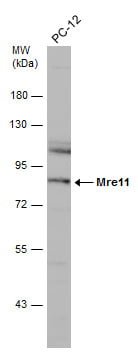
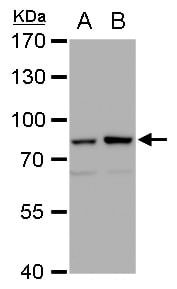
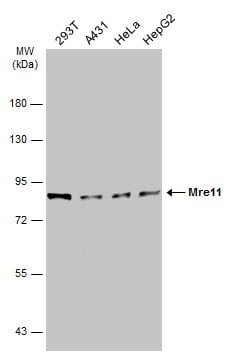
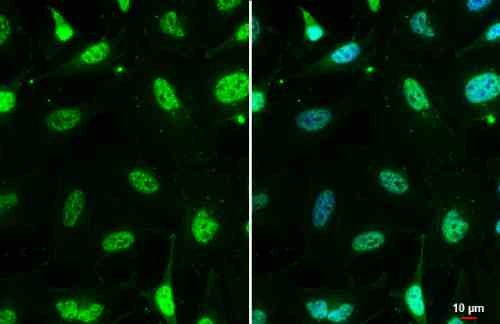
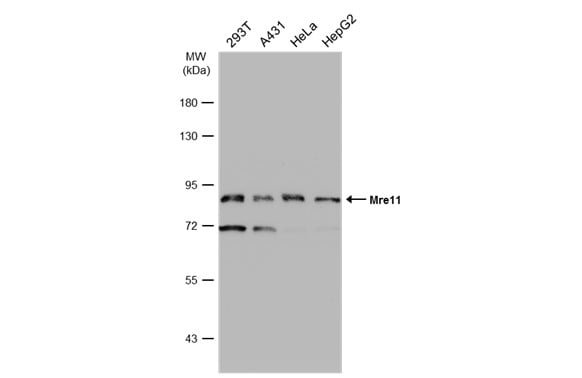
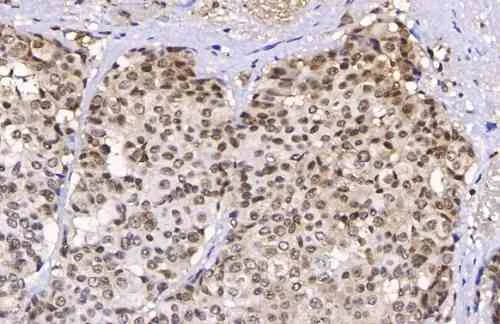
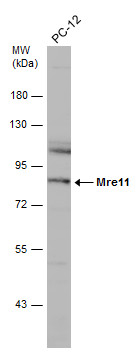
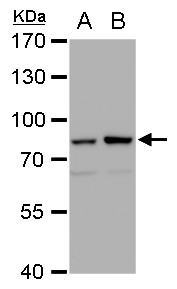
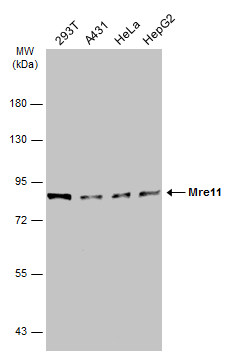
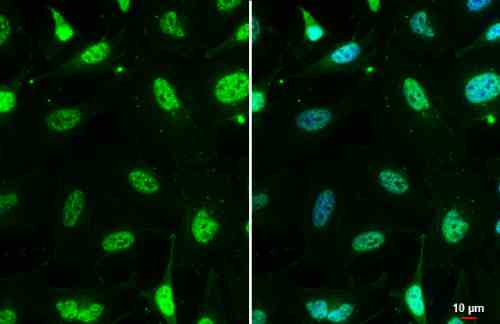

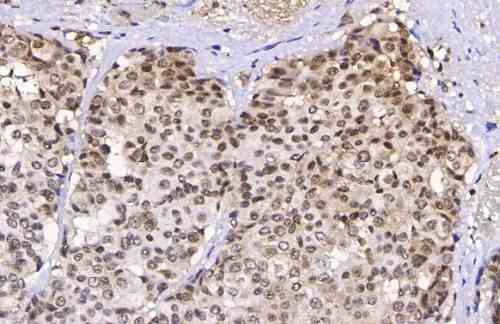
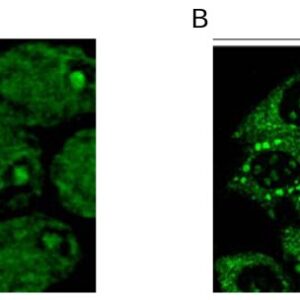
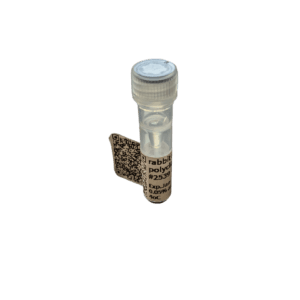
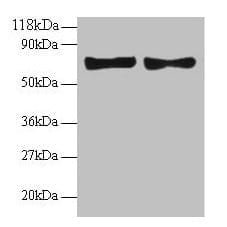
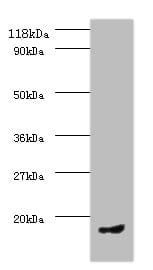

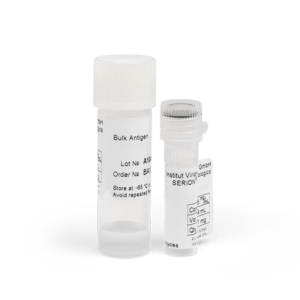
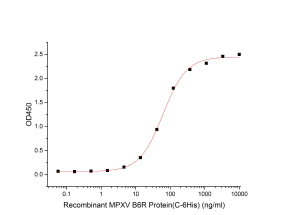
Reviews
There are no reviews yet.